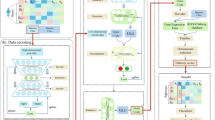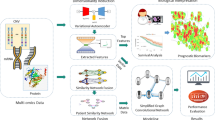Abstract
Cancer is a complex and heterogeneous disease, and effective diagnosis and treatment require accurate description of tumor subtypes. Traditional cancer identification methods based on clinical and histopathological criteria have limitations in identifying crucial molecular subtypes. In recent years, high-throughput genomics technologies have changed cancer research and made it possible to characterize tumor molecular features on a large scale. The integration of multiple genomic data types is expected to provide a more comprehensive understanding of the potential molecular mechanisms of cancer and facilitate the discovery of new diagnostic and therapeutic targets, but new computational methods need to be developed. In this study, we propose MultiDAAE (Multi-omics Double Adversarial Autoencoder) by combining autoencoders with two discriminators, which forms two generative adversarial networks and is able to more effectively extract features and reduce dimensionality of multi-omics data. Compared to state-of-the-art methods, our approach exhibits excellent clustering performance in multiple cancer datasets. In summary, MultiDAAE can help reveal potential molecular mechanisms and provide insights for the development of personalized cancer therapies.
Access this chapter
Tax calculation will be finalised at checkout
Purchases are for personal use only
Similar content being viewed by others
References
Stingl, J., Caldas, C.: Molecular heterogeneity of breast carcinomas and the cancer stem cell hypothesis. Nat. Rev. Cancer 7(10), 791–799 (2007)
Dai, X., et al.: Breast cancer intrinsic subtype classification, clinical use and future trends. Am. J. Cancer Res. 5(10), 2929 (2015)
Xiong, L., Liyue, L., Juan, Z.: Heterogeneity analysis and diagnosis of complex diseases based on deep learning method. Sci. Rep. 8(1), 6155 (2018)
Li, X., et al.: A clustering method unifying cell-type recognition and subtype identification for tumor heterogeneity analysis. IEEE/ACM Trans. Comput. Biol. Bioinf. 20(2), 822–832 (2022)
Dienstmann, R., Vermeulen, L., Guinney, J., Kopetz, S., Tejpar, S., Tabernero, J.: Consensus molecular subtypes and the evolution of precision medicine in colorectal cancer. Nat. Rev. Cancer 17(2), 79–92 (2017)
Reuter, J.A., Spacek, D.V., Snyder, M.P.: High-throughput sequencing technologies. Mol. Cell 58(4), 586–597 (2015)
Tomczak, K., Czerwińska, P., Wiznerowicz, M.: Review the cancer genome atlas (TCGA): an immeasurable source of knowledge. Contemporary Oncology/Współczesna Onkologia 2015(1), 68–77 (2015)
Sammut, S.-J., et al.: Multi-omic machine learning predictor of breast cancer therapy response. Nature 601(7894), 623–629 (2022)
Rappoport, N., Shamir, R.: Multi-omic and multi-view clustering algorithms: review and cancer benchmark. Nucleic Acids Res. 46(20), 10546–10562 (2018)
Ghojogh, B., Ghodsi, A., Karray, F., Crowley, M.: Generative adversarial networks and adversarial autoencoders: Tutorial and survey. arXiv preprint arXiv:2111.13282 (2021)
Razavian, A.S., Azizpour, H., Sullivan, J., Carlsson, S.: CNN features off-the-shelf: an astounding baseline for recognition. In: Proceedings of the IEEE Conference on Computer Vision and Pattern Recognition Workshops, pp. 806–813 (2014)
Otter, D.W., Medina, J.R., Kalita, J.K.: A survey of the usages of deep learning for natural language processing. IEEE Trans. Neural Networks Learn. Syst. 32(2), 604–624 (2020)
Yang, H., Chen, R., Li, D., Wang, Z.: Subtype-GAN: a deep learning approach for integrative cancer subtyping of multi-omics data. Bioinformatics 37(16), 2231–2237 (2021)
Kingma, D.P., Ba, J.: Adam: a method for stochastic optimization. arXiv preprint arXiv:1412.6980 (2014)
Gulli, A., Pal, S.: Deep Learning with Keras. Packt Publishing Ltd. (2017)
Martín Abadi, et al.: Tensorflow: large-scale machine learning on heterogeneous distributed systems. arXiv preprint arXiv:1603.04467 (2016)
Duan, R., et al.: Evaluation and comparison of multi-omics data integration methods for cancer subtyping. PLoS Comput. Biol. 17(8), e1009224 (2021)
Troyanskaya, O., et al.: Missing value estimation methods for DNA microarrays. Bioinformatics 17(6), 520–525 (2001)
Hoadley, K.A., et al.: Cell-of-origin patterns dominate the molecular classification of 10,000 tumors from 33 types of cancer. Cell 173(2), 291–304 (2018)
Frank, E.H.: Regression modeling strategies with applications to linear models, logistic and ordinal regression, and survival analysis (2015)
Campello, R.J.G.B., Hruschka, E.R.: A fuzzy extension of the silhouette width criterion for cluster analysis. Fuzzy Sets Syst. 157(21), 2858–2875 (2006)
Picard, M., Scott-Boyer, M.-P., Bodein, A., Périn, O., Droit, A.: Integration strategies of multi-omics data for machine learning analysis. Comput. Struct. Biotechnol. J. 19, 3735–3746 (2021)
Menyhárt, O., Győrffy, B.: Multi-omics approaches in cancer research with applications in tumor subtyping, prognosis, and diagnosis. Comput. Struct. Biotechnol. J. 19, 949–960 (2021)
Subramanian, I., Verma, S., Kumar, S., Jere, A., Anamika, K.: Multi-omics data integration, interpretation, and its application. Bioinform. Biol. Insights 14, 1177932219899051 (2020)
Acknowledgments
This work was partially supported by Project of Scientific Research of Hunan Provincial Education Department (No. 22C1397, No. 22A0022), the Natural Science Foundation of Hunan Province (No. 2023JJ30161, No. 2024JJ8004). And it was also supported by the Changsha City takes the lead in major science and technology projects (No. KQ2102002).
Author information
Authors and Affiliations
Corresponding author
Editor information
Editors and Affiliations
Ethics declarations
Data Availability
The data that support the findings of this study are available from the TCGA request.
1 Electronic supplementary material
Below is the link to the electronic supplementary material.
Rights and permissions
Copyright information
© 2024 The Author(s), under exclusive license to Springer Nature Singapore Pte Ltd.
About this paper
Cite this paper
Chen, X. et al. (2024). A Novel Approach for Subtype Identification via Multi-omics Data Using Adversarial Autoencoder. In: Peng, W., Cai, Z., Skums, P. (eds) Bioinformatics Research and Applications. ISBRA 2024. Lecture Notes in Computer Science(), vol 14954. Springer, Singapore. https://doi.org/10.1007/978-981-97-5128-0_41
Download citation
DOI: https://doi.org/10.1007/978-981-97-5128-0_41
Published:
Publisher Name: Springer, Singapore
Print ISBN: 978-981-97-5127-3
Online ISBN: 978-981-97-5128-0
eBook Packages: Computer ScienceComputer Science (R0)




